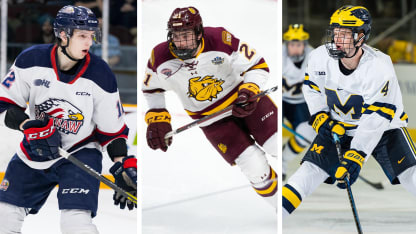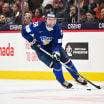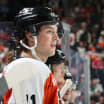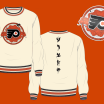In Part One of our three-part midseason series on how Flyers prospects have faired to date this season, we looked at the young players on the Lehigh Valley Phantoms and Reading Royals. Flyers assistant general manager Brent Flahr provided his insights.
In Part Two, the focus shifts to prospects playing collegiate hockey in the U.S. or junior hockey in Canada.
MELTZER: Flahr on the Farm, Part 2
A look at Cam York, Mason Millman, Noah Cates and other Flyers prospects from Bill Meltzer and AGM Brent Flahr.

By
Bill Meltzer
philadelphiaflyers.com
THE NCAA
CAM YORK
The Flyers' 2019 first-round pick has battled a pair of lower-body injuries during his freshman season at Michigan but has had a strong overall year on a team that has struggled to score goals. York, the No. 1 defenseman last season on a stacked US National Under-18 Team, performed well at the World Junior Championships Summer Showcase and was the only 18-year-old defenseman on the Team USA roster for the 2019-20 WJC. However, he ended up playing very sparingly at the Worlds. York has since rejoined Michigan, which earned a win and a tie at Penn State before playing (and losing to) the US National Under-18 squad in an exhibition game last week.
"I think Cam hoped and expected to play more at the World Juniors, but it was what it was. It caught us by surprise. But he'd be the only returning defenseman next year, and it's usually been a 19-year-old's tournament," Flahr said.
"With Cam, a lot of the focus is on his offense, his mobility and his skills with the puck. He has the upside to be a power play defenseman when he turns pro. But we like his overall makeup and his game. Very poised. Good defensive stick. Quick on retrievals. Very good first pass. His game is pretty consistent; it doesn't change much from game to game. He needs to add strength and muscular weight. That will help him when he's competing against pro players."
It is uncertain whether York, who is AHL eligible because he falls under a different set of rules than CHL players, will sign an entry-level contract after his freshman year or return to Michigan for his second season. Flahr indicated that he and the organization are comfortable with whatever direction York goes after this season. Primarily, it's a matter of his physical readiness.
"It's a very long season in the pros. College hockey is the weekends and there are fewer games. You see a large percentage of even the top young players hit the wall after a little while their first year at the pro level. It's the competition level but also just the physical grind. So that's always part of the consideration; how physically ready the player is, as well as mentally ready. York is pretty strong mentally. On the physical side, we'll have to see," Flahr said.
BOBBY BRINK
Another 18-year-old who saw time with Team USA at the World Juniors, the Flyers' 2019 second-round pick made the most of his own limited ice time.
"He was playing on the top power-play unit but on the fourth line at five-on-five. I think he stood out in a positive way. Bobby is very skilled offensively but he's also extremely competitive. He's one of the smallest players on the ice most nights but he battles and battles. There's a high desire to compete and he's one of the players who has the motor going most of the time. He still need get considerably stronger physically, and that's not going to happen overnight," Flahr said.
As a freshman at Denver this season, Brink has made an instant impact; carrying over the success he had last season in the USHL for Sioux City and in six appearances for the U.S. National Under-18 team. Brink is almost certain to play a second collegiate season, and is a lock for the next World Junior Championships barring injury.
Going into the 2019 NHL Draft, the primary factor that kept Brink out of the first round was the combination of concerns over his size and skating; similar to the reason why Alex DeBrincat went 39th in the 2016 Draft. Flahr said that Brink's skating is not a concern from a fundementals standpoint and added strength will help him in this area as well as holding up in physical battles.
Bottom line: There's no rush on Brink but the organization views him as a player they expect to be a regular producer in the NHL down the line.
TANNER LACZYNSKI
One of two collegiate seniors in the Flyers' prospect ranks, the 22-year-old Ohio State product and former Team USA Under-20 national team member (2016-17 WJC gold medalist squad) has been a versatile and consistent two-way player the collegiate level for several years. He's able to play both center and wing, and moved back in the middle this season to center the Buckeyes' top line. He missed some time in the first half due to injury, but has bounced right back.
Laczynski is a physically mature prospect. He's not a beautiful skater or speed demon but he gets around sufficiently and takes good routes. Physically and emotionally, the belief among many scouts is that he can compete as a pro in the near future -- possibly even at the NHL level -- as a useful forward who can be plugged into different spots in the lineup as needed.
Ohio State is a Frozen Four contender again this season, which means that Laczynski could be playing beyond the period where many collegiate players who turn pro after their seasons sign their ELC and, as a condition of signing, their NHL team burns the first year of the contract by getting him into at least one game by the end of the regular season. If Ohio's season wraps up a bit early, he'd be available a bit sooner to the Flyers and/or Phantoms.
The Flyers retain Laczynski's NHL sigining rights until Aug. 15, 2020. Flyers general manager Chuck Fletcher has said the organization has a strong relationship with Laczynski as well as Wade Allison. The reason why Laczynski did not take part in Development Camp last summer was that he was taking a summer course at college, and NCAA rules prohibit camp participation when enrolled in a class. One year earlier, an injury kept him off the ice at Development Camp. Laczynski did take part in previous Flyers summer camps.
"I don't think signability is going to be problem. Ultimately, that will be his decision, but there's a fit here and an opportunity, I would say. Tanner is a mature all-around player and he's a guy you can project as a pro. We will see what happens," Flahr said.
WADE ALLISON
Back in late December of 2017, it seemed like Allison, whom the Flyers selected late in the second round of the 2016 Draft, was on a fast-track to a pro career. As a sophomore at the University of Western Michigan, he was blossoming as a goal scorer with a booming shot and as a muscular, large-framed player who did not shy away from physical contact.
Then Allison suffered a complete ACL tear shortly after the Christmas break. The injury ended his sophomore season prematurely and delayed the start of his junior campaign. Unfortunately, Allison needed about 18 months from the time of the ACL injury -- and also suffered unrelated physical issues -- and it essentially ruined his junior year, too.
Feeling he still had unfinished business at Western Michigan and not wanted to start his pro career as an injury rehabbing player playing catch-up in looking for ice time at the American Hockey League level, Allison remained at college for his senior year.
Yet again this season, Allison has had season interruptions due to injuries. It's only been recently that he's finally gotten healthy and started to resemble the player he was two seasons ago. At present, he has a four-game goal streak going, including a four-point game (1g-3a) against Colorado College on Jan. 18.
As with Laczynski, both the Flyers organization and the 22-year-old Allison himself, will have a decision to make when his season ends. If unsigned, he can become an unrestricted free agent on Aug. 15. Fletcher and Flahr have both stated that the Flyers organization maintains a good relationship with both players.
"That [ACL] injury was unfortunate and cost him a lot of time, but he's got a big body, good strength and can score goals. Hopefully, he can finish up strong this season now that he's back in the lineup and has had some success again of late," Flahr said.
NOAH CATES
Coming off an eye-opening freshman season for NCAA national champion Minnesota Duluth and for Team USA at the 2018-19 World Junior Championships, the 20-year-old has taken another step forward as a sophomore.
Cates has shown himself to be an above-average 200-foot player, who can be deployed effectively in a variety of different situations. He has a knack for making the right reads. Offensively, he's second on the team in scoring and clicked not only with his brother, Jackson Cates, but with whomever he's played.
"Noah is a coach's dream; the type of player that every coach loves to have on a team. He pays attention to detail; picks up fast on things, makes good plays, has a good work ethic and is a smart player. He doesn't cheat out of the [defensive] zone early, doesn't have to be stayed on to back-check, but he can also put up some points," Flahr said.
"Whether he turns pro after this season or not, I don't know right now. It's not a rush. It depends on his physical readiness, and how much strength he adds. His skating is fine, but he can add strength for a little more explosiveness. That would benefit him at the pro level. We'll talk to Noah after the season, see what his thoughts are [in regard to turning pro or playing his junior season]. Obviously, Minnesota Duluth is a program that's had a lot of success, and we'd be comfortable with him playing another year there if that's how it works out."
Ultimately, Cates' own inclinations for his immediate future will weigh as heavily in the decision as the consensus within the Flyers organization. Some players feel more comfortable with an extra year of collegiate or European hockey -- for instance, Oskar Lindblom in 2016 or James van Riemsdyk in 2008 -- while others feel ready to take the leap to the pros when an entry-level deal becomes an available option.
Last year, some in the Flyers organization felt that 2018 first-round pick Joel Farabee would have benefited from a collegiate sophomore season just from a physical development standpoint. However, both Farabee himself and the organization were confident that his mature on-ice game and hockey IQ were sufficient to be just about NHL-ready and would enable him to work around any physical development questions in the short term.
Cates, who was a teammate of Farabee and Jay O'Brien on last year's Team USA squad at the World Juniors, is not as much of a fast-track prospect as Farabee. After being drafted by the Flyers out of high school, Cates spend a season in the USHL to better ready himself for NCAA hockey. Given his upward trajectory each of the last three seasons -- Cates has a chance to develop into a solid pro.
WYATT KALYNUK
Another late-blooming prospect, Kalynuk will turn 23 on April 14. Now in his junior collegiate year, he was a 20-year-old freshman at Wisconsin in 2017-18 after the Flyers selected him in the seventh round (196th overall) of the 2017 NHL Draft out of the USHL. Once in college, Kalynuk quickly proved himself to be an above-average offense defenseman with plus mobility. He immediately became a regular on the Badgers' power play.
Now a junior playing in a stacked team that includes the likes of highly touted NHL prospects Cole Caufield, Alex Turcotte and New York Rangers defense prospect K'Andre Miller, Kalynuk is second on the team in scoring. His all-around game has also taken strides over the course of his college career.
"I think Wyatt can be a pro. Yes, he's a power play guy but there are other elements to his game that he's developed. He's in a good place right now. Again, he's another player that we'll see where his thoughts are at after this season [in regard to turning pro or playing his senior season]. We wouldn't be uncomfortable with either direction," Flahr said.
Given the numbers game on the Flyers' blueline and the demands of playing defense in the NHL, Kalynuk might benefit from some time with the Phantoms. An offensive minded defenseman and power play regular in college, current Phantoms/Flyers defenseman Mark Friedman turned pro after three college seasons. It took him time to adapt to the pros -- which, in Friedman's case, involved simplifying and remaking certain aspects of his game.
In Kalynuk's case, being part of a power play and joining the attack is part of the intrigue of his pro upside. However, he's not only a defenseman who can be pigeonholed with a "power play point man or bust" descriptor in terms of his potential to become a pro.
RONNIE ATTARD
A late-blooming defenseman who opened eyes last season in the USHL by racking up 34 goals, 64 points and 66 penalty minute in 48 games, Attard brings a booming shot, a big frame (6-foot-3, 207 pounds), a bit of swagger and a penchant for aggressive physical hockey. A freshman this season at Western Michigan, where his teammates include Wade Allison and Buffalo Sabres prospect Mattias Samuelsson (son of Flyers development coach Kjell Samuelsson), Attard will turn 21 on March 20.
Attard missed six games due to injury earlier this season but recently returned and scored goals in back-to-back games against St. Cloud State. Overall, he has begun his college career with six goals and nine points through his first 18 games.
In addition to working on his skating, Attard seeks to improve his overall game and risk-reward decisions when it comes to pushing the offense and initiating physical play; in the USHL, he was often branded more of a rover than a defenseman, but he has been working on adapting. Flahr noted that the pro game especially, but also collegiate hockey, puts a premium on playing effectively within structure. He also said that Attard's overall game made more strides even pre-Draft than some of the player's critics suggest.
"He's another player who is a good program and he's a self-aware young man. The injury was a temporary setback,"
GAVIN HAIN
A sophomore this season at North Dakota, Hain is a product of the U.S. National Team Development Program. He played both center and left wing for the USNTDP but has been a winger at the collegiate level. He has moved around the lineup as a sophomore but often within the top nine.
"Hain, when he's effective, is a straight-line player. He got away from that for awhile this season but, in the last month or so, has gotten back to playing that way and he's played better. In the long term, if he develops, he is a bottom six type of forward," Flahr said.
Hain is still just 19 years old. He doesn't turn 20 until April 3, and patience will be required. It is almost a lock that he will need a third collegiate season and, quite possibly, his senior year after that to develop to a point where an entry-level contract would be a viable option. The Flyers hold his rights until Aug. 15, 2022.
JACK ST. IVANY
Now a 20-year-old sophomore at Yale, St. Ivany was yet another Flyers prospect who earned a spot on Team USA at last year's World Junior Championships. The California native has shown himself at the collegiate level to be a good puck-mover with the ability to also join the attack and contribute some offense to the mix. St. Ivany has a good frame -- 6-foot-2, 200 pounds --to go along with his puck skills.
"He's another guy that [former general manager Ron Hextall and assistant general manager Chris Pryor] selected a litte later in the draft. The Flyers scouts have a good job with the high school and USHL players," Flahr said.
The Flyers selected St. Ivany out of the USHL in 2018 with the 112th overall pick of the Draft. It was his second year of NHL Draft eligibility. Kalynuk, who will turn 21 on July 22, is another late-blooming prospect who is still a work in progress by has already come a significant way from where he was prior to being drafted.
As with many past and current prospects from Ivy League universities, there is no rush on St. Ivany turning pro. He's still developing in various aspects of his game, including his feet and adding strength, while also balancing athletics with a demanding academic workload.
While St. Ivany does not appear to be a candidate for an imminent entry-level contract offer, he could emerge as one after his junior or senior season if he continues his upward development trajectory.
BRYCE BRODZINSKI
A Minnesota high school and USHL offensive standout whom the Flyers selected in the seventh round (196th overall), Brodzinski is the son of Philadelphia native and former minor league forward Mike Brodzinski. As a freshman this season at Minnesota, Brodzinki has chipped in seven points through his first 24 games.
There are many aspects of his game that Brodzinski must work on to eventually become a pro hockey candidate, including his skating and two-way awareness, but the right winger has always shown good hands.
Flahr indicated that the organization will monitor the player's progress from year to year.
THE BCHL
JAY O'BRIEN
After being selected with the latter of the Flyers' two picks in the first round of the 2018 NHL Draft, Jay O'Brien was a standout at the WJC Summer Showcase for Team USA and parlayed it into a roster spot at last year's World Juniors.
Unfortunately, not much went right for the former Thayer Academy star, once the 2018-19 regular season started. He had a hard time adapting as a freshman at Providence and also dealt with several upper-body injuries including a concussion. O'Brien scarcely saw the ice at the WJC, playing only one or two shifts (if any at all) in entire games.
As a late-year birthday (born Nov. 4, 1999) who wasn't eligible for the NHL Draft until 2018 but had already aged out of WJC eligibility this past fall, O'Brien's international junior career ended before it ever had a chance to take off.
After his disappointing freshman season at Providence, O'Brien decided that he needed a change of scenario. He transfered to Boston University. However, NCAA rules require a transfer player to sit out a year of college hockey before they are eligible to play for a new school.
Additionally, because players in Canadian major junior hockey receive monetary stipends, O'Brien would have had to forfeit his remaining NCAA eligibility if he had played in the CHL this season. The NCAA does permit transfer players to play in an amateur league such as the USHL or a Canadian Junior A league in the interim, which is why O'Brien took a backwards step in level of competition to join the Penticton Vees of the British Columbia Hockey League for the 2019-20 season.
The hope was that one step backwards could help him take several forward when he goes back to the NCAA next season for what will still officially be his sophomore season. The Flyers' hold on his rights, which would have been until Aug. 15, 2022 if he'd played four consecutive NCAA seasons, is now extended until 2023. That means there is still plenty of time to track O'Brien's progress and future readiness for an NHL contract.
O'Brien dominated the BCHL pretty much right off the bat this season. Unfortunately, he suffered a fractured foot, and was sidelined for more than a month. Upon his recent return, he picked up where left off. Through his first 38 games, O'Brien has racked up 54 points (20g-35a).
"You would expect him to put up big scoring numbers at that level, which he has. What's more important to me is that he's enjoying playing hockey again. He's just playing the game and all the skills and speed he was showing before are evident again. He's got his confidence back in making plays. What happened last season is behind him now. He'll be going to a good BU program next year, and we'll see where that leads," Flahr said.
WESTERN HOCKEY LEAGUE
EGOR ZAMULA
Although they are of different physical makeups, Egor Zamula and current Flyers defenseman Phil Myers have taken oddly similar early career paths. Both went unselected in the NHL Draft. Both were signed by the Flyers to entry-level contracts off impressive performances as training camp invitees and then had breakout junior seasons. In what would be their traditional draft-plus-two years, both players improved even further and went on to claim top defense pairing spots on their national teams (Team Canada in Myers' case, Russia in Zamula's) at the World Junior Championships.
Prior to the WJC, Zamula was having an outstanding two-way season for the Western Hockey League's Calgary Hitmen. However, it was at the WJC where Zamula truly opened eyes as he led the Russian team in ice time, played strong all-around hockey with only a few isolated hiccups and began the tourney with a two-goal game.
"Egor was very good in training camp for us, even in the [NHL] exhibition games he played, and he just kept right on going. It was impossible not to notice him at the World Juniors this year. He still needs to add some strength to compete up here. Overall, though, he has a good foundation that he will take into his first pro season next year," Flahr said.
Shortly after the World Juniors, Zamula and the Hitmen announced that the player needed season-ending back surgery; another odd parallel to Myers, who missed most of the second half of his final junior season due to injury (a concussion suffered at the WJC in his case). Flahr said that there are no long term concerns over the 19-year-old Russian defenseman's health, and that he should be 100 percent for training camp.
Both in the WHL and the World Juniors, Zamula saw extensive use on the power play as well as even strength and the penalty kill. Flahr does not project Zamula necessarily as a power play regular in the pros but, instead, as a skilled puck-mover who is also savvy without the puck on his stick. The player's poise and feet are already above-average for a defenseman his age.
WYATTE WYLIE
Wylie is technically an overager in the Western Hockey League this season, as he turned 20 during the fall. Correspondingly, he was eligible for the AHL this season, but the Flyers opted to reassign him to the WHL's Everett Silvertips. The Flyers have until June 1 to sign Wylie to an NHL entry-level contract or else the organization will relinquish his rights.
"It was about playing time, above all," Flahr said of the decision to send Wylie back to his junior team. "With Everett, he gets a lot of ice time and carries a lot of responsibilities. We didn't know how much time he would be able to get with the Phantoms or Royals. He's had a good season this year."
Wylie has put up strong offensive numbers this season for Everett, speaking to his adaptability to different roles. However, if Wylie were to eventually play in the NHL, it would not be in a role conclusive to posting many points. He would not see much, if any, power play time or be likely to deployed in 3-on-3 situations to go for a win in overtime. Rather, it is the level of defensive responsibility, willingness and prowess to block shots and be part of a penalty killing rotation -- all of his are aspects of his junior hockey repertoire -- that make Wylie a candidate to be signed to a professional contract.
"He's become a leader for that team and he sees hard minutes. I think that's where his biggest strengths are," Flahr said.
RODDY ROSS
Selected by the Flyers in the sixth round (169th overall) of the 2019 NHL Draft, the 19-year-old goaltender rose from obscurity last season to be a revelation in net for the Seattle Thunderbirds over the latter portion of the 2018-19 after joining the team from the Junior A (Alberta Junior Hockey League) level.
This season, Ross has been a workhorse for the Thunderbirds, starting 35 of the team's first 45 games. The team has struggled, and Ross has often been peppered with both a high quantity and high difficulty of shots; which is tough on both a goalie's stats and won-loss record.
"Brady Robinson has worked quite a bit with him in addition to his coaches up there. Like most goalies his age, he is very raw. But we like his size, his compete and the upside if he can put everything together at some point," Flahr said.
Part of the conundrum in drafting goaltenders from the CHL is that there is only a two-year window to evaluate the prospect's development and decide whether to sign him to an entry-level contract. Conversely, an NCAA or NCAA-track goalie can have up to a four-year or even a five-year evaluation window before a signing decision must be made. Likewise, there is a much lengthier window to evaluate prospects playing in Europe.
For this reason, many NHL organizations nowadays are more likely to draft a comparably ranked NCAA/European league goalie rather than one from major junior hockey. Of course, this does not apply to exceptionally gifted goalies, such as Carter Hart, who will be selected in the early rounds of the Draft regardless of where they they played in their Draft-eligible season.
In Ross's case, the Flyers were intrigued enough by both the raw materials he possesses and by his demonstrated performance in his first exposure to major junior hockey to roll the dice on a late-round selection. He's progressing, albeit not to the point where he's likely to be signed this year. The Flyers hold his rights until June 1, 2021.
ONTARIO HOCKEY LEAGUE
MASON MILLMAN
Exceptional mobility, raw puck skills and willingess to press the attack were the primary lures that led to the Flyers selecting the Saginaw Spirit blueliner in the fourth round (109th overall) of the 2019 NHL Draft. This year, after showing promise during the Flyers Rookie Camp in September, Millman got off to a rocky start.
"They play a go-go-go style in Saginaw. The good part was that Millman was putting up points. The bad part was that he went backwards defensively. But that's pretty correctable, and he has the tools to develop into a good all-around defenseman. Overall, he's progressing," Flahr said.
Through 43 games, Millman already bagged a dozen goals and 30 points. There were times where discipline lapsed in terms of abandoning structure to freelance and taking himself off the ice (53 penalty minutes) but it is harder to motivate a low-motor player than it is to help a more aggressive one to better pick his spots.
Traditional plus-minus ratings are of limited analytical usefulness in many cases because they speak more to offensive output than defense and are also heavily reliant on goalie save percentage. Nevertheless, it's something to which both coaches and many players still pay attention and on which players still pride themselves for being significantly on the positive side.
Toward that end, it is worth noting that Millman started out the season with a minus-12 rating through the first nine games of the campaign. Since then, he's plus-25 in his last 34 games. He also has 11 goals and 30 points it that span.
At 6-foot-1 and 180 pounds, Millman needs to add strength to his frame to compete at higher levels but size is not a long-term concern once he fills out a bit more. There's no questioning his feet, which are well above-average, but there is still work to be done in the consistency of his all-around game.
When he's on, Millman can turn in some eye-opening performances. His best stretch of the season came shortly after New Year's as he surged for three goals and seven points over a three-game span and flashed his ability to play at top speed.
QUEBEC MAJOR JUNIOR HOCKEY LEAGUE
EGOR SERDYUK
Last year, Serdyuk led all QMJHL rookies with 25 goals among his 65 points in 63 games. There were some notable limitations in his game apart from his hands, which caused him to drop deep into the 2019 NHL Draft before the Flyers selected him in the 6th round (165th overall), but the organization felt that he could diversify his game as he gained more experience and added strength to a slight frame (5-foot-11, 165 pounds).
This season, the Victoriaville Tigers right winger blasted out of the gates with
six goals (including a hat trick in the season's second game) and seven points through the first four games. Then he got injured, missed time, and hasn't been quite healthy or consistently productive since. Overall, he dressed in 35 of the season's first 48 games (12g-17a).
"He still can't really push off on one side, so that's a big part of [the reason for Serdyuk's inconsistency]. He's going to need surgery. We're evaluating whether
he can play through it the rest of the season and get the surgery afterwards or whether it makes more sense to shut him down and get it done now. He's been pretty productive offensively of late," Flahr said.
Over his last nine games this month, Serdyuk has a pair of goals and nine points. Back in December, he had at least one point in five of the seven games in which he able to dress.
Serdyuk's overall game has taken modest strides this season, but not to the point where he'd have gone significantly higher in a theoretical one-year re-draft of the leaguewide 2019 Draft crop. Keep in mind, however, that the injury has hampered Serdyuk's development curve in his draft-plus-one season.
Serdyuk will turn 19 on June 3. If healthy next season, he is a potential candidate for the Russian team at the 2020-21 World Junior Championships.


















